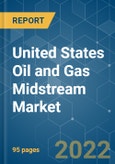The US oil and gas midstream market is expected to register a CAGR of more than 4.15% during the forecast period of 2022-2027. The United States oil and gas midstream market was fairly unaffected by the COVID-19 pandemic since the constant usage of storage facilities for storing hydrocarbons, usage of pipelines for fuel transportation, and resilient demand for LNG in 2020 increased the demand for midstream services in the country amid pandemic. Factors such as increasing investments in the pipeline sector and increasing production and consumption of oil and gas are expected to boost the demand for the United States oil and gas midstream market during the forecast period. Additionally, upcoming LNG terminal projects are also expected to drive market growth. However, the high volatility of crude oil prices coupled with a drop in consumption is expected to hinder the US oil and gas midstream market during the forecast period.
The US oil and gas midstream market remains fragmented, with key players such as American Midstream Partners LP, Chevron Inc., BP PLC, Tenaris SA, and Shell Midstream Partners LP, among others.
This product will be delivered within 2 business days.
Key Highlights
- The transportation segment is expected to dominate the United States oil and gas midstream market during the forecast period, owing to the upcoming pipeline projects.
- Increasing investments and development of complex offshore fields are expected to increase the demand for midstream services. Therefore, this factor is expected to provide a great opportunity for the US oil and gas midstream sector during the forecast period.
- An increasing gas pipeline network is expected to drive the growth of the US oil and gas midstream market significantly during the forecast period.
Key Market Trends
The Transportation Segment Expected to Dominate the Market
- The pipeline is the most economical way of transporting natural gas, crude oil, and petroleum products over a long distance. As of 2020, the US pipeline network has about 3 million miles of mainline and other pipelines that link natural gas production areas and storage facilities with consumers.
- According to the US Energy Information Agency, As of October 2021, there are ten petroleum pipeline projects in the United States currently in the construction phase, including new pipelines and expansions such as the Enbridge Line 3 Replacement project.
- Furthermore, in 2020, the United States exported natural gas to about 32 countries. The total annual US natural gas exports were 5.28 trillion cubic feet (tcf). Owing to this, the transportation segment is witnessing significant growth in the United States oil and gas market.
- In August 2021, Dakota Access Pipeline (DAPL) expansion project increased the capacity by 180,000 barrels per day (b/d) along with the DAPL system. The capacity of DAPL has been increased by 180,000 b/d to 750,000 b/d.
- Moreover, in May 2021, Kern River Gas Transmission Co. announced the Delta Lateral project, designed to provide transportation service for 140,000 Dth/d (dekatherm) from Opal, Wyoming, to the Intermountain Power Project (IPP) near Delta, Utah. The project will include a 35.84-mile, 24-inch diameter pipeline and is expected to get commissioned by 2024.
- Owing to such developments, the transportation segment is expected to dominate the US oil and gas midstream market during the forecast period.
Increasing Gas Pipeline Network to Drive the Market
- The US is witnessing a rising demand for natural gas, particularly in the power sector. Any disruption in the gas supply can cause disruption in power generation, which, in turn, can affect gas suppliers, the power industry, along with the manufacturing sector.
- As of 2020, the United States had consumed 30.48 trillion cubic feet of natural gas, which is comparatively higher than the 27.24 tcf consumed in 2015.
- In 2020, the natural gas transportation network delivered about 27.7 trillion cubic feet (Tcf) of natural gas to about 77.3 million customers. About 55% of the total US natural gas exports in 2020 were by pipeline, of which 69% went to Mexico and 31% went to Canada. Exports of LNG increased each year substantially from 2015 through 2020.
- In April 2021, Venture Global LNG inc. received US Federal Energy Regulatory Commission permission to start service on the 23.4-mile TransCameron LNG pipeline. The line will deliver gas from interconnects with multiple interstate pipelines at Grand Cheniere station to Venture Global’s 10-million ton/year (tpy) Calcasieu Pass LNG plant.
- Further, the US Department of Energy (DOE) issued a final rule to accelerate the approval process for small-scale export of natural gas, including LNG. The initiative aims to accelerate the DOE’s processing of small-scale export applications and reduce administrative burdens for the small-scale natural gas export market. The rule will enable LNG projects with an estimated export capacity of one metric ton per annum or under to avoid the current extensive permitting procedure.
- As a result, increasing investment in natural gas infrastructure, including pipelines and LNG facilities, to meet the growing demand for the same is expected to translate into huge investment in the coming years.
Competitive Landscape
The US oil and gas midstream market remains fragmented, with key players such as American Midstream Partners LP, Chevron Inc., BP PLC, Tenaris SA, and Shell Midstream Partners LP, among others.
Additional Benefits:
- The market estimate (ME) sheet in Excel format
- 3 months of analyst support
This product will be delivered within 2 business days.
Table of Contents
1 INTRODUCTION
4 MARKET OVERVIEW
5 MARKET SEGMENTATION
6 COMPETITIVE LANDSCAPE
Companies Mentioned (Partial List)
A selection of companies mentioned in this report includes, but is not limited to:
- Kinder Morgan Inc.
- Enbridge Inc.
- Energy Transfer Operating LP
- Enterprise Products Partners LP
- Williams Companies Inc.
- MPLX LP
- ONEOK Gas Transportation LLC
- Plains All American Pipeline LP
- WhiteWater Midstream Inc.
- Maritimes & Northeast Pipeline
- Atlantic Coast Pipeline










